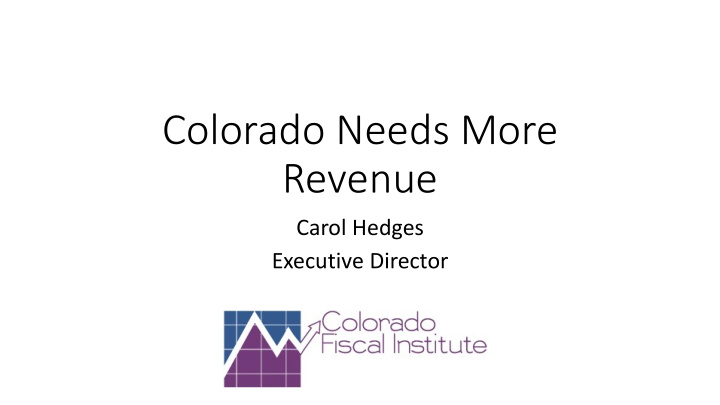



Colorado Needs More Revenue Carol Hedges Executive Director
Direct Decrease Aid to People, Communities, Costs in Tax Businesses Collections
Impact o of CO COVID D – Direc ect C Costs o of I Increa eased ed S State S Servi vices es Unclear and unknowable One estimate is between $700 and $800 Million
Impact t of C COVID—Lo Lost R Rev even enue Uncertainty is the most common component Projections say Reduction in General Fund Revenue of $3.3 billion (25%) Up to $7 billion for ‘FY 20 through ‘FY 22 Historically the roughest year for the state budget is the one following the end of Federal Emergency Assistance
Impa pact o of C COVID D -- --Cost o of those Le Left Ou Out Individual relief Cash Relief payments -- ITIN Filers Unemployment Insurance Payments --How Long Before Workers Are Hired Back Business relief PPP and beyond Community Assistance Sales tax dependent most vulnerable now Property Tax dependent impacted more in the future
Federal Assistance Essential but Inadequate COVID Relief fund- -$1.67 B for state (separate amounts for areas with population > 500k) Medicaid enhanced match Education Relief Our guestimate of total State CARES allocation (excluding FEMA and Families First) to date: $2.532 b More is being discussed but how much and when?
Reserves Important Now and in the Future Two reserves: Emergency Reserves that equal 3% of Fiscal Year Spending— Limited utility for addressing shortfalls Statutory Reserves that equal 7.25% of General Fund Spending Research shows reserves are essential in year after federal support ends.
Closing Tax Expenditures a Limited Option List of Possible Sources is much less than the total of $3.6 billion What does the 2020 Dirty Dozen look like: CFI thinks maybe $130-150 million What we think is possible is different than what others think
Emergency Tax? What’s that? TABOR authorizes Emergency taxes -- Art X Section 20 (6) 2/3 vote required Have to deplete emergency reserves Remains in effect until Nov 2020
Emergency Definition What is an Emergency? (2) Term definitions (c) "Emergency" excludes economic conditions, revenue shortfalls, or district salary or fringe benefit increases.
Colorado Can’t Afford More Cuts • Need all options on the table • Need everyone pulling for more revenue • Need voices talking about how public systems are connected
What Kind of Tax? Needs to reduce impact on low- and moderate-income earners Share of income paid in state and local taxes in CO Fairer than Current Upside-Down system $ 2,662 $ 8,979 $81,875 8.7% G enerates significant money 6.4% 4.6% $30,600 $140,300 $1,779,900 Household Income
Income Bracket Income Tax Rate Colorado’s Current Difference in Income Tax Rate Percentage Points Below $250,000 4.58% 4.63% -0.05 pp $250,000 to $500,000 7.00% 4.63% 2.37 pp $500,000 7.75% 4.63% 3.12 pp to $1,000,000 $1,000,000+ 8.9% 4.63% 4.27 pp Up to $2 billion Possible Annual Revenue Generated
Taxing Wealthy to Avoid Cuts is Popular In a recent poll, 68% of Colorado Voters Prefer a new tax on wealthy Coloradans over cuts to schools, roads and health care (18%) Majority support among Democrats, Unaffiliated and Republicans
It is going to be challenging to pass an emergency tax. But so is running a school district, a school or a classroom after these cuts
Short Term and Long Term Consequences Require Solutions Emergency Tax 271 Fairtaxcolorado.org
Recommend
More recommend